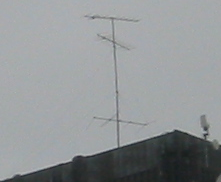I am old enough to remember when everyone got their TV from an antenna. As part of my ongoing program to seem different and strange I have continued to do this while pretty much everyone else changed over to cable/satellite/IPTV. Recently, receiving TV with an antenna has become a "thing" and I find myself engaged in an activity that could actually be considered sort of popular.
This thing is now generally called over the air (OTA) TV. The OTA movement was prompted by the transition from analog to digital television transmission methods. This is a mostly technical change. Mastery of this sort of change is an activity that appeals to the geeky set.
Some interesting aspects of this transition are:
- The new digital transmission methods support high definition (HD) video and multichannel sound. For example the Canadian networks transmit a 1920x1080 image at a bit rate of around 15 Mbps using MPEG-2 video compression. Most also supply 5.1 surround sound.
- The quality of the high definition video received via OTA tends to be better than cable/satellite/IPTV. This is because OTA reception eliminates at least one extra video decompression/compression step.
- OTA TV is easy to record on a computer based PVR system. It eliminates the bother of finding a way to change channels on the cable/satellite/IPTV box. It also eliminates an extra video decompression/compression operation normal to this application. You end up with the actual transmitted bit stream on the disk (7 GB/hour).
- It is a new excuse to mess around with antennas and spend time on the roof while doing so.
Analog television was quite hard to do well. For purposes of spectral efficiency (this was real important for uncompressed video) the video signal was represented as the amplitude of the transmitted signal (Amplitude Modulation (AM)). This means that any noise that affected the amplitude of the received signal showed up directly in the video. This makes analog TV insanely susceptible to most kinds of noise. The standard way of dealing with this was to just let the viewer filter it out perceptionally after they became accustomed to it. A type of noise known as ghosting was particularly hard to ignore.
Here is what one of my local analog channels looks like:

There is a lighter image of the logo and the horizontal blanking interval to the right of where these things should be. Somehow a portion of the signal is being held up in flight for a time and then is sent along to cause the scanning system used to interpret the result as a duplicate image. It turns out that this is not actually caused by some sort of temporal anomaly as one might immediately assume. Instead it is caused by the reflection of the signal off an object which causes a path that is longer than the primary path.
With knowledge of the timing of the scanning system used it is possible to determine the extra path length from the offset of the ghost in the received image. I have done the calculations for the ghosting shown in the image above and now know that the extra path length is 4.3 km. That implies that the object causing the ghost is at least a few km away. This is a bit remarkable. A reflected radio signal is attenuated by; distance to the reflecting object, the infinitesimal portion of the signal reflected, and the distance to the receiver. It turns out that an AM TV system is an excellent detector of reflected signals. One source claims that reflections attenuated by 40 dB can sometimes be perceived as ghosts. In terms of signal level this is a factor of 100. Analog TV has a parasitic radar functionality that provides the unhelpful information that there are large objects around somewhere.
Back when "TV Antenna Installer" was an actual job description, the elimination of ghosting was a huge problem. The (mostly abandoned) work of the professional installer can still be seen on the roofs of apartments in the city I live in. Here is an example that reflects the TV RF environment of the mid 70s:

This antenna is on the top of an 8 story apartment building. The signal levels available were very high but the installer has used one high gain antenna for each of the 3 local signals s/he was trying to receive. That is because the antennas are not being used for their ability to produce a larger signal but instead are being used for their ability to reject reflected signals arriving at angles away from their centre line (directivity). It turns out that antenna gain is the best weapon in the struggle to produce a good analog TV image. In addition to a collection of high gain antennas the pro installer had a collection of filters that could be used to prevent the signals from the various antennas from combining in unfortunate ways. As the RF environment was different at each installation site it was likely one of those jobs that provided new and interesting challenges.
The residential TV enthusiast did not have as much experience or as many resources available to them. The installation task often involved the rotation of a single antenna so as to make all the channels equally mediocre. As residential TV reception tends to be seasonal, the homeowner would sometimes find themselves up on the roof in the middle of the first snow storm of the winter. Such experiences tended to make the idea of subscribing to a cable distribution system attractive when such things became available.
So ... the point of this section is: Analog TV wasn't very good...
posted at: 12:41 | path: /tv | permanent link to this entry